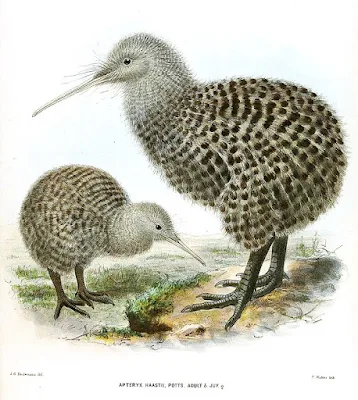20+ Interesting Facts About Kiwi Birds
- Kiwi is a small flightless and tailless bird endemic to New Zealand. They belong to ratites, a group of flightless birds spread on various continents.
- Kiwi is the only nocturnal bird among ratites. They hide in their burrows during the day and search for food during the night.
- There are five kiwi species: brown kiwis, southern brown kiwis (tokoeka), great spotted kiwis, little spotted kiwis, and rowi kiwis. The largest is the great spotted kiwi, while the little spotted kiwi is the smallest species.
- Kiwis are the smallest among ratites (ostriches, rheas, cassowaries, etc.) but produce the largest egg relative to its body weight (15% or more) in the avian kingdom. Females lay this egg every year primarily using their stored energy reserves. The egg contains 65% yolk, and its hard shell protects the chick from small predators. (Source)
- The closest extinct relative of chicken-sized kiwis is the elephant bird - the largest bird ever. DNA comparisons have proved that kiwis are closely related to elephant birds of Madagascar instead of moa of New Zealand. Even the closest living relatives of kiwis are emus and cassowaries from Australia, not the birds from New Zealand. According to estimates, the ancestors of kiwis were flying birds, but they lost this ability later. (Source)
- Nearly 5% of kiwi chicks can survive into adulthood. Their main predator is the stoat, a mammal introduced to New Zealand during the 19th Century. Two other non-native mammals, dogs and ferrets, also pose a significant risk to these flightless birds.
- Female
kiwis are usually larger than males. In most species, male kiwis incubate eggs
for 75 to 90 days. Chicks hatch fully feathered and feed without assistance
from parents. However, they may stay with their parents for up to a year.

Kiwi chicks hatch fully-feathered and feed without assistance - Kiwis have the smallest eyes relative to body mass and the smallest visual fields among birds. According to a study, kiwis can survive without vision due to the high development of other sensory systems (olfactory, auditory, and touch). (Source)
- Kiwis have one of the best senses of smell among birds. According to a study, olfactory bulbs in kiwis are larger than their (living and extinct) close relatives and several other birds. (Source)
- The kiwi is the only bird with nostrils at the tip of its beak. This position assists the flightless bird in finding its food (worms, insects, seeds, berries, etc.) on and underground. The same feature makes this beak technically the shortest among birds.
- Kiwis are one of the few monogamous animals. They may keep their relationship from 10 to 30 years.
- Kiwis are the only birds where females generally have both right and left functional ovaries. Most birds have only left functional ovaries, while two functional ovaries are present rarely and irregularly in some other birds. (Source)
- Kiwis have one of the longest lifespans among birds. The average age for adults is 50 years, while some can live for up to 100 years in favorable conditions. (Source)
- New Zealand has taken several steps to increase the Kiwi population. They have formed several sanctuaries and started Operation Nest Egg (hatch eggs or raise chicks in captivity and then return to the wild). These measures have increased the survival rate of chicks up to 65% compared to a 10% survival rate in the wild.
- Kiwis have generally brown feathers, but a rare genetic trait can turn these feathers into white in some birds. Therefore, there are very few white kiwis in the wild, while the only such kiwi born in captivity died in 2020. (Source)
- Kiwis have powerful legs that they use to run briskly. Their thick feet enable the bird to walk silently on the forest floor. They use their legs and claws on four toes during a fight.
- Like cats, kiwis also have whiskers. These hairs assist this nocturnal bird in finding food on the ground.
- Research has proved that kiwis have a higher brain-to-body ratio than their relatives and many other birds. Parrots, songbirds, and some other birds are the only ones with more intelligence than kiwis. (Source)
- 1080 is a common name for a biodegradable poison to control undesirable mammals such as rats and possums. Anti-1080 campaigners used fake images of dead kiwis twice (in 2011 and 2018) to spread misinformation about this poison. However, scientists have rejected these claims, and statistics have proved its effectiveness in protecting kiwis. (Source)
- Kiwis’ preferred habitat is the wet and steep forests of New Zealand. However, they have adapted to semi-pastoral land after the arrival of non-native predator mammals.
- Kiwi has been used as a symbol of New Zealand since the beginning of the 20th Century. However, its relationship with New Zealand grew after WW1. The bird got a place in New Zealand currency during the 1930s.
- Kiwi name refers to the call of the male bird. New Zealanders named kiwifruit, a small Chinese gooseberry, after kiwi bird in 1959.



Comments
Post a Comment